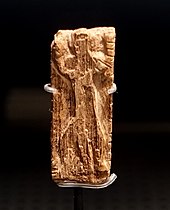Geissenklösterle (arula)
|
Geissenklösterle arula, tigisa koe Schwäbische Alb jakama getalte Germana, tir ayaf is abdiizvugalaf debak ke Lekeraporugal. Tamavafa GadakiewegabetaraBelca dem tevoya abdiizvugalafa arula ( don Geissenklösterle arula ) milvemon tigisa getalte Germana va tano katcalapafo izvaxo ke tawava tadler nume bak 2007 wetce arayaf debak ke tamavafa gadakiewega ke UNESCO zo bendeyer. Rawopaf debakbetaraGeissenklosterle arula tir tela lolentefa ke baroya arula ke Ach krant. Kolanixo ke betsa vatalteon tigir, vwon ice 60 m- vamoe titak ke krant. Ostik nelkafa galza atitsumuyur. Rawopafa kowedira koe lirkiskafa darka vakrile galza zo sopuyud. Uzif plor riyunaf gu fultey zo kosmayar voxe men al zo kojoxar. Aneyasik malyedad da bat plor vas kotunon videweyesi seri jontikote co ruldayar. Bata rawopafa muka gu rekola wali Milgaf Lekeraporugal ( pilkovon ke Moustier Sare ) is Mialukraporugal co zo royofted. Loa koafizayana olkotca koe Geissenklosterle arula gu -39000 ik -33000 ( Aurignac Sare ) zo evlayad. Kosmayan mukeem vas yon sulemkoraf kudjotam is skunderi is baroy val tulon ruldar, i muka epuyuna kum melmakolafa wula ok kum sulemafa talga ok zverifa niska. Tel lokiewon videweyes val kum drinca ke bregay ke ape dankas loror zo epuyur. Betsa va badopaf enk wali 10000 ik 50000 AR tanda al divnedir Geissenklosterle arula ( rusunon sugdalasa vas reak ke deaxol ) bak toleafu acku ke 1950-e sanda zo kosmayar aze tozi 1970-e sanda zo kosuxayar. Tana muka koafizayana koe luvafa betsava tigisa koe Blaubeuren widava, tir fetintekoramaf abidaf balumaks volas va ayasulemaf tisik. Muka epuyuna kum wula ke melmakolafa talgava tir lumontinafa vas 3.4 cm- is lummantafa vas 1.4 cm-. Gu 32000 AR tanda zo evlayar. Vrutaks va dzetafa yamba bal joxara va arula dere zo karavotayad. Luvafa betsava, dum Hohle Fels arula, va kalkafi dri lingeyeni is evlafi gu guazafe Aurignac Sare al razdar.
Dere rupecbetara |
| |||||||||||||||||||||||||||||||||||||||||||||||||||||||||
Vuestexa
betara
- (en) Fiona Coward is Robert Hosfield is Matt Pope is Francis Wenban-Smith, The Early Upper Paleolitic and the art of Central Europe, Settlement, Society and Cognition, ed. Human Evolution , Cambridge University Press, 2015, 448 p. [1]
- (en) Michael Bolus, The Swabian Jura, History of Research and the Aurignacian of the Sites in the Swabian Jura, Nuria Sanz, Human origin sites and the World Heritage Convention in Eurasia, ed. UNESCO, vol. n° 41, 2015, p. 166 [2]
- (en) Timothy Insoll, The Oxford Handbook of Prehistoric Figurines [3]
- (en) Andreas Taller is Michael Bolus is Nicholas J. Conard, The Magdalenian of Hohle Fels Cave and the Resettlement of the Swabian Jura after the LGM, Modes de contacts et de déplacements au paléolithique eurasiatique, Actes du Colloque international de l'UISPP, Université de Liège, 28–31/05/2012, coll. « Erault et Archéologiques », 2014, ISBN 978-2-87985-305-5 [4]
- (en) Suzanne Münzel is Friedrich Seeberger is Wulf Hein, The Geißenklösterle Flute – Discovery, Experiments, Reconstruction, Studien zur Muzikarchäologie, Rhaden, 2002
- (en) Joachim Hahn is Linda R. Owen, Blade technology in the Aurignacian and Gravettian of Geissenklösterle Cave, Southwest Germany, World Archaeology, vol. 17, no 1 « Studying stones », 1985
- (de, en) Luc Moreau, Geißenklösterle. The Swabian Gravettian its European context / Geißenklösterle. Das schwäbische Gravettien im europäischen Kontext, Quartär, vol. 57, 2010
- (en, fr) João Zilhão is Francesco D'Errico, An Aurignacian Garden of Eden in southern Germany? An alternative interpretation of the Geissenklö̈sterle and a critic of the Kulturpumpe model, Paléo, n° 15, 2003
- (fr) Henri Laville is Joachim Hahn, Les dépôts de Geissenklösterle et l'évolution du climat en Jura souabe entre 36 000 et 23 000 B. P., Comptes rendus des séances de l'Académie des sciences, vol. 292, t. 2 « Mécanique-physique, Chimie, Sciences de l'univers, Sciences de la Terre », 1981
- (en) Nicholas J. Conard is Gerlinde Dippon is Paul Goldberg, Chronostratigraphy and Archeological Context of the Aurignacian Deposits at Geißenklösterle, The chronology of the Aurignacian and of the transitional technocomplexes, Lisboa, 2003
- (de) Stephan M. Heidenreich is Conny Meister, UNESCO Welterbe Höhlen und Eiszeitkunst der Schwäbischen Alb, Land Baden-Württemberg, Landesamt für Denkmalpflege, 2017
- (de) Thomas Striebel, Höhlen im Gebiet der Stadt Blaubeuren, Das Jahresheft 1995 der Arge Grabenstetten - Ausgabe zum VDHK-Jahrestreffen 1996 in Blaubeuren, vol. 15, 1996, Geißenklösterle 7624/15
- (en) Nicholas J. Conard, The demise of the Neandertal Cultural Niche and the beginning of the Upper Paleolitic in the Southwestern Germany, koe Nicholas J. Conard is Jürgen Richter, Neanderthal Lifeways, Subsistence and Technology : One Hundred Fifty Years of Neanderthal Study, Springer Science & Business Media, 2011
- (en) Michael Bolus, The Swabian Jura : History of Research and the Aurignacian of the Sites in the Swabian Jura, UNESCO, 2015
- (de) Berrin Çep, Ausgangsbasis oder Versorgungsstandort? Raumnutzung im Mittel- und Jungpaläolithikum des Ach- und Blautals bei Blaubeuren, Quartär, vol. 60, 2013
- (en) Fiona Coward is Robert Hosfield is Matt Pope is Francis Wenban-Smith, The Early Upper Paleolitic and the art of Central Europe, Human Evolution, Cambridge University Press, 2015
- (en) Suzanne C. Münzel, Subsistence patterns in the Gravettian of the Ach valley, a former tributary of the Danube in the Swabian Jura, Proceedings of the Mikulov conference, 20.–21. 11/ 2002, Brno, Institute of Archaeology, DOI 10.13140/RG.2.1.4552.4962.
- (fr) Joachim Hahn, Demi-relief aurignacien en ivoire de la grotte Geissenklösterle, près d'Ulm (Allemagne Fédérale), Bulletin de la Société préhistorique française, t. 79, n° 3, 1982, DOI 10.3406/bspf.1982.5364.
- (en) Suzanne Münzel is Friedrich Seeberger is Wulf Hein, The Geißenklösterle Flute – Discovery, Experiments, Reconstruction, Studien zur Muzikarchäologie, Rhaden, 2002
- (de) Nicholas J. Conard is Maria Malina is Susanne C. Münzel is Friedrich Seeberger, Eine Mammutelfenbeinflöte aus dem Aurignacien des Geißenklösterle : Neue Belege für eine musikalische Tradtion im Frühen Jungpaläolithikum auf der Schwäbischen Alb, Archaologisches Korrespondenzblatt, Verlag des Römisch-Germanischen Zentralmuseums, vol. 34, n° 4, 2004
- (de) Joachim Hahn, Eine aurignacienzeitliche Menschendarstellung aus dem Geißenklösterle bei Blaubeuren, Alb-Donau-Kreis, Denkmalpflege in Baden-Württemberg, vol. 9, no 2, 1980, ISSN 0465-7519




